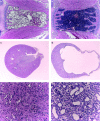The haemotoxicity of mitomycin in a repeat dose study in the female CD-1 mouse
- PMID: 16309546
- PMCID: PMC2517448
- DOI: 10.1111/j.0959-9673.2005.00452.x
The haemotoxicity of mitomycin in a repeat dose study in the female CD-1 mouse
Abstract
Mitomycin (MMC), like many antineoplastic drugs, induces a predictable, dose-related, bone marrow depression in man and laboratory animals; this change is generally reversible. However, there is evidence that MMC may also cause a late-stage or residual bone marrow injury. The present study in female CD-1 mice investigated the haematological and bone marrow changes induced by MMC in a repeat dose study lasting 50 days. Control and MMC-treated mice were dosed intraperitoneally on eight occasions over 18 days with vehicle, or MMC at 2.5 mg/kg, autopsied (n = 6-12) at 1, 7, 14, 28, 42 and 50 days after the final dose and haematological changes investigated. Femoral nucleated bone marrow cell counts and levels of apoptosis were also evaluated and clonogenic assays carried out; serum levels of FLT3 ligand (FL) were assessed. At day 1 post-dosing, MMC induced significant reductions in RBC, Hb and haematocrit (HCT) values, and there were decreases in reticulocyte, platelet, and femoral nucleated cell counts (FNCC); neutrophil, lymphocyte and monocyte values were also significantly reduced. On days 7 and 14 post-dosing, all haematological parameters showed evidence of a return towards normal values, but at these times, and at day 28, values for RBC and FNCC remained significantly reduced in comparison with controls. At days 42 and 50 post-dosing, many haematological parameters in MMC-treated mice had returned to control levels; however, there remained evidence of late-stage effects on RBC, Hb and HCT values, and FNCC also continued to be significantly decreased. Results for granulocyte-macrophage colony-forming units and erythroid colonies showed a profound decrease immediately post-dosing, but a return to normal values was evident at day 50. Serum FL concentrations demonstrated very significant increases in the immediate post-dosing period, but a return to normal was seen at day 50 post-dosing; a relatively similar pattern was seen in the number of apoptotic femoral marrow nucleated cells. The histopathological examination of kidney tissues from MMC animals at day 42 and 50 post-dosing showed evidence of hydronephrosis with cortical glomerular/tubular atrophy and degeneration. It is therefore concluded that MMC administered on eight occasions over 18 days to female CD-1 mice at 2.5 mg/kg induced profound changes in haematological and bone marrow parameters in the immediate post-dosing period with a return to normal levels at day 50 post-dosing; however, there was evidence of mild but significant late-stage/residual effects on RBC and FNCC, and on cells of the erythroid lineage in the bone marrow.
Figures

Similar articles
-
The haemotoxicity of azathioprine in repeat dose studies in the female CD-1 mouse.Int J Exp Pathol. 2008 Apr;89(2):138-58. doi: 10.1111/j.1365-2613.2008.00575.x. Int J Exp Pathol. 2008. PMID: 18336531 Free PMC article.
-
Characterization of the myelotoxicity of chloramphenicol succinate in the B6C3F1 mouse.Int J Exp Pathol. 2006 Apr;87(2):101-12. doi: 10.1111/j.0959-9673.2006.00460.x. Int J Exp Pathol. 2006. PMID: 16623754 Free PMC article.
-
Haemotoxicity of busulphan, doxorubicin, cisplatin and cyclophosphamide in the female BALB/c mouse using a brief regimen of drug administration.Cell Biol Toxicol. 2011 Feb;27(1):13-40. doi: 10.1007/s10565-010-9167-1. Epub 2010 Jun 30. Cell Biol Toxicol. 2011. PMID: 20589437
-
Serum FLT-3 ligand in a busulphan-induced model of chronic bone marrow hypoplasia in the female CD-1 mouse.Int J Exp Pathol. 2008 Apr;89(2):159-70. doi: 10.1111/j.1365-2613.2008.00580.x. Int J Exp Pathol. 2008. PMID: 18336532 Free PMC article.
-
Toxicology and carcinogenesis studies of androstenedione (CAS No. 63-05-8) in F344/N rats and B6C3F1 mice (gavage studies).Natl Toxicol Program Tech Rep Ser. 2010 Sep;(560):1, 7-31,33-171 passim. Natl Toxicol Program Tech Rep Ser. 2010. PMID: 21037592 Review.
Cited by
-
Efficacy of the new therapeutic approach in curing malignant neoplasms on the model of human glioblastoma.Cancer Biol Med. 2021 Jul 14;18(3):910-30. doi: 10.20892/j.issn.2095-3941.2020.0511. Online ahead of print. Cancer Biol Med. 2021. PMID: 34259424 Free PMC article.
-
The haemotoxicity of azathioprine in repeat dose studies in the female CD-1 mouse.Int J Exp Pathol. 2008 Apr;89(2):138-58. doi: 10.1111/j.1365-2613.2008.00575.x. Int J Exp Pathol. 2008. PMID: 18336531 Free PMC article.
-
Treating colorectal peritoneal metastases with an injectable cytostatic loaded supramolecular hydrogel in a rodent animal model.Clin Exp Metastasis. 2023 Jun;40(3):243-253. doi: 10.1007/s10585-023-10210-0. Epub 2023 May 22. Clin Exp Metastasis. 2023. PMID: 37211565 Free PMC article.
-
Predominant role of cytosolic phospholipase A2α in dioxin-induced neonatal hydronephrosis in mice.Sci Rep. 2014 Feb 10;4:4042. doi: 10.1038/srep04042. Sci Rep. 2014. PMID: 24509627 Free PMC article.
-
Use of Self-Assembled Colloidal Prodrug Nanoparticles for Controlled Drug Delivery of Anticancer, Antifibrotic and Antibacterial Mitomycin.Int J Mol Sci. 2022 Jun 18;23(12):6807. doi: 10.3390/ijms23126807. Int J Mol Sci. 2022. PMID: 35743251 Free PMC article.
References
-
- Alter BP, Potter NU, Li FP. Classification and aetiology of the aplastic anaemias. ClinHaematol. 1978;7:431–465. - PubMed
-
- Appelbaum FR, Fefer A. The pathogenesis of aplastic anaemia. SeminHematol. 1981;18:241–257. - PubMed
-
- Benested HB. Drug mechanisms in marrow aplasia. In: Geary CG, editor. Aplastic Anaemia. London: Ballière-Tindall; 1979. pp. 26–42.
-
- Benning VM, Maratrat MB, Fournier EC, Melcion CP, Cordier AC. Flow cytometric detection of erythropoietic cytotoxicity in mouse bone marrow. JHistochem Cytochem. 1991;39:15–21. - PubMed
-
- Bertho JM, Demarquay C, Frick J, et al. Level of Flt3-ligand in plasma: a possible new bio-indicator for radiation-induced aplasia. Int. J. RadiatBiol. 2001;77:702–712. - PubMed
Publication types
MeSH terms
Substances
LinkOut - more resources
Full Text Sources
Medical
Miscellaneous

